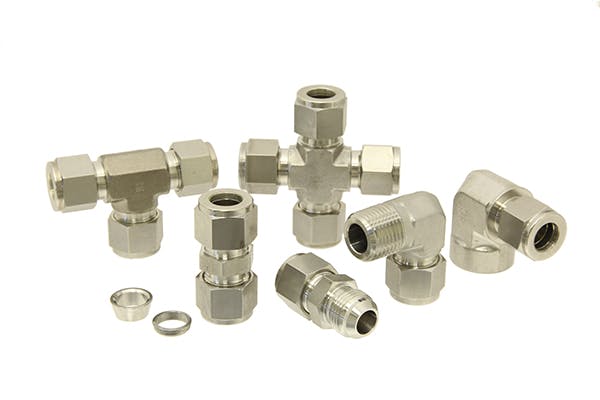What are Dual Ferrule Instrumentation Fittings?

Image Description: An image showing an industrial machine with a network of stainless steel pipes fittings and adapters
Instrumentation in process plants is essential for measuring various parameters like flow, conductivity, temperature, ion count, and pressure. The measurement and transmission of these parameters to governing control systems allow processes to be controlled without human intervention. They need to be connected via relevant piping to gather data from process media. Piping connected to these machines commonly uses dual-ferrule compression style fittings. Here, we look at what they are and why the industry regularly utilizes them.
Construction
Dual ferrule instrumentation fittings consist of three components:
- Body: The body houses the ferrule(s) and has straight United National Extra Fine (UNEF) threads on either side for a compression nut to lock onto or an adapter to fit into.
- Ferrule(s): Instrumentation fittings come in a single and dual ferrule construction; however, their working mechanisms differ only slightly.
- Compression Nut: The compression nut, when tightened, forces the ferrules to deform and hold onto the piping while also sealing the fitting to prevent media egress.
Working Mechanism
As mentioned above, the working mechanism differs depending on the type of ferrule used. For single ferrule Instrumentation fittings, there is only one cone-shaped ferrule that sittings on top of the recessed center bore of the body. The metal tubing fits between the ferrule and goes through the bore. When the locking nut is tightened, it forces the cone-shaped ferrule to deform, hinge, and bite onto the metal tubing.
In a dual ferrule instrumentation fitting, there is an additional back ferrule accompanying the cone-shaped front ferrule. The back ferrule has two jobs: to apply even pressure onto the front ferrule for adequate deformation and to provide an additional seal by biting into the tubing at its point of contact.
In either case, the ferrules are machined to match the recessed bore they fit into, providing metal to metal sealing, eliminating the need for flaring a tube before installation. Moreover, having fine threads on the body enables a tight locking action for the nut such that threads don’t strip when being tightened.
Advantages of using Dual Ferrule Instrumentation Fittings:
There are many advantages to using a dual ferrule instrumentation fitting:
- The market is flooded with these types of fittings. They come in various shapes, like elbows and tees, for a number of tube sizes.
- The seal they form is via metal-to-metal contact; hence, it becomes difficult for media to flow out once assembled.
- Since the ferrules bite into the tubing, it makes them suited to resist vibrations.
- They are easy to install, requiring minimal preparation, parts assembly, and nut tightening to finish the job.
Disadvantages of using Dual Ferrule Instrumentation Fittings:
Although dual ferrule instrumentation fittings are industry favorites, they do have some disadvantages.
- More number of parts means that there is a likely chance of error when assembling.
- Once the ferrules bite onto the tubing, they become permanently attached to it. Hence, changing fittings requires the tubing to be replaced as well.
- Wrong tubing size selection may result in leaks due to improper sealing.
- The tubing quality matters immensely. It needs to have a smooth finished surface for the ferrules to bite properly.